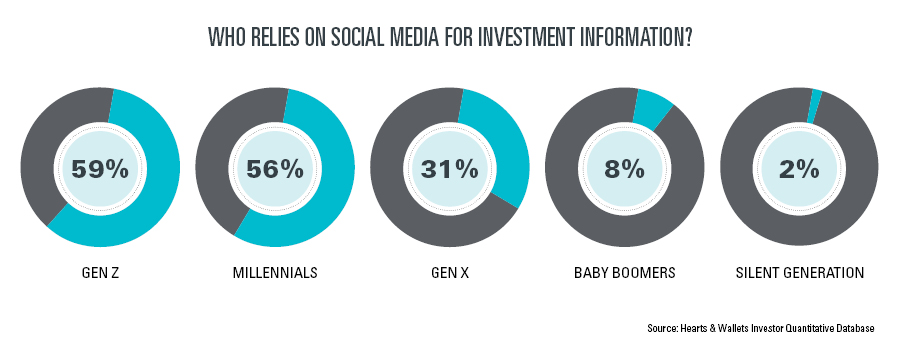

One of the first videos that popped up after Brad Klontz’s nephews introduced him to TikTok was a flashy clip about how day trading is a way to get rich.
Klontz, who previously worked as a psychologist at a low-income high school in Hawaii, had missed talking with kids and decided he needed to be a voice of reason on a platform that is largely devoid of it.
“I got so angry and upset that this misinformation was being pumped into the brains of young people that I got on and started to make videos,” he said.
Klontz might seem like the ideal financial professional to be on TikTok. As a CFP, he’s credentialed – and he also has a doctorate in psychology. He founded the Financial Psychology Institute, and he’s written numerous books on money. His RIA, YMW Advisors, has over $600 million in assets under management.
But on TikTok, none of that really matters, he said.
“You have to throw that out the window. I’m competing with a 19-year-old who’s a freshman in college, who took their first finance class,” he said. “You can’t be boring. You have to grab people in the first five seconds. You have to compete with all the people who are shilling get-rich-quick schemes.”
Klontz has more than a million followers on social media, including 843,000 on TikTok.
More important than credentials – at least to get people’s attention – is boldness, he said.
“People are afraid that they’re going to look stupid or cringe,” he said. “If you want to teach compound interest, you have to compromise yourself, package it in a way to get people’s attention. I start videos with, ‘You’ll be poor forever if you do these things.’”
Meeting people where they are
Social media is the new storefront, Klotz said.
“It’s really targeting that audience who is in desperate need of accurate information,” he said.
More than half of Gen Zers and millennials rely on social media for investing information, along with nearly a third of Gen Xers, according to 2023 data from consumer research firm Hearts & Wallets.
Figures from Finra and the CFA Institute show that 37 percent of people in Gen Z listen to social media influencers, listing that as a major part of their decisions to invest.
Those figures have not been lost on the wider financial services industry, which has applied increasingly sophisticated social media strategies to marketing efforts. It’s also led to the portmanteau “finfluencer” and the phenomenon of finance outsiders and celebrities hawking individual securities and cryptocurrency services.
Gen Z is particularly drawn to financial guidance from social media as over 60 percent of investors of that generation have no formal financial education, and finfluencers provide content that can be approachable and entertaining, according to research by the CFA Institute.
A recent analysis by that group of finfluencer posts across YouTube, TikTok, and Instagram found that about 45 percent included guidance, 36 percent had investment promotions, and 32 percent made investment recommendations. But of the recommendations, only one in five included any kind of disclosure about professional status or compensation from products. And over half of the promoted investment content included any disclosures, CFA Institute found.

“For the most part, this was not marketing promotions by celebrities. It was individuals who have some level of [financial] knowledge,” said one of the authors, Rhodri Preece, senior head of industry research at CFA Institute.
Despite the problems with much of the finfluencer content, the fact that nearly half of the sample was guidance, rather than recommendations, was encouraging, Preece said.
“There is a positive side to that. It’s increasing access to information and introducing to young people concepts about finance and investing, which can increase participation in the capital markets,” he said. “On the flip side… recognizing that it’s free [content] means that the quality of that information is not always fully reliable. It’s hard to discern the professional qualifications of the finfluencers.”
And because social media is global, regulating financial content is tricky. Definitions of recommendations and advice varies by jurisdiction, Preece noted.
Having some level of harmonization about disclosure rules would help finfluencers and other content creators, as they would more easily understand what is expected of them, he said.
Running afoul of regulators
Of course, the US Securities and Exchange Commission has not been shy about charging numerous celebrities in connection with cryptocurrency marketing that wasn’t properly disclosed, as well as asset managers that didn’t make clear their arrangements with promoters. The regulator has also taken action against an RIA over its 200-member finfluencer program.
And in March, Finra issued its first fine over a brokerage’s use of finfluencers.
Further, the Consumer Financial Protection Bureau issued an interpretive rule in 2022, specifying that digital marketers for financial services firms can be considered service providers under federal law and subject to liability over unfair, deceptive, or abusive practices.
Although the SEC made it possible for investment advisors to allow endorsements and testimonials under its marketing rule that went into effect in 2022, meeting the requirements is not easy, said Matt Shepherd, director at ACA Group.
“Looking at it objectively... it’s not impossible to do this. There is a roadmap built into the rule to allow you to use a finfluencer,” Shepherd said. “You’ve got to hit everything in that list of bullet point [requirements] in order to do that.”
While an investment advisor has the compliance staff capable of that, the same might not be true of the celebrities it would contract with, which makes things complicated, he said.
Still, the SEC’s prior rules didn’t allow such arrangements at all, so even if difficult to work with, the newer marketing rule at least makes it possible, he said.
“The risk of getting it wrong has dissuaded people in the past,” he said. “I don’t think it’s becoming more or less prevalent, because I don’t think it was that prevalent before.”
What works
About four in 10 financial advisors report having gotten new clients through social media, a figure that hasn’t changed much over the past few years, data published this year by Broadridge show. The highest likelihood of attracting clients came through LinkedIn and Facebook, according to that report.
But the types of content financial professionals put online matters. Though many have an abundance of ready-to-go corporate materials, that format doesn’t get attention nearly as much as original content, survey data issued this week by Hearsay Systems show.
“When they make a post personal and it’s sharing something about what they’re involved in in their community that content gets 10 times the engagement of the content that’s prepared by their marketing folks,” said Leslie Leach, chief marketing and strategy officer at Hearsay.
However, only 4.4 percent of the financial services social media content published last year was original, down from 6.5 percent in 2022, according to the firm.
What people want to see from advisors is a mix of educational material and information that shows their personality and what it’s like to work with them, Leach said. Posts about community involvement, causes they support and personal notes about their lives and families are a plus, she said.
Among the different sites, Instagram has shown strong engagement numbers, while LinkedIn and Facebook have the highest levels of total activity, she said.
“You don’t have to be everywhere – just do a good job on one or two networks,” she said. “You’ll do better if you customize what you do to that network. What does well on LinkedIn isn’t going to resonate on Instagram.”
Results may vary
Social media “is the way people communicate now,” said Mara Derderian, lecturer of finance at Bryant University. “It has the greatest reach and greatest opportunity to let your clients know you’re thinking about them” and the financial needs they have, Derderian said.
Despite the proliferation of questionable finfluencer guidance, there is also a lot of helpful content, she noted. People should be careful to vet their sources, checking for education and credential for example, she said.
“You can play around on the internet without having to sit in front of a financial advisor,” which makes topics more approachable, she said. “There is a lot of value to that. The younger generation is getting more curious about [finance] because of social media.”
People shouldn’t just take advice from a finfluencer and invest accordingly – they should do their homework first and research other sources, she said.
“I really do believe it’s up to you as the consumer… [and] the good old expression ‘buyer beware,’” she said.
Research published last year by the Swiss Finance Institute found that only 28 percent of finfluencers are “skilled,” outperforming peers by an average of 2.6 percent monthly. Another 16 percent are “unskilled,” and 56 percent show “negative skill,” with their below-average returns at negative 2.3 percent monthly.
Klontz, who has become a TikTok finfluencer by trying to educate younger folks, has gotten clients because of his online presence. While many advisors are worried about the compliance risks, he urges them to get off the sidelines and help put useful content out there to combat the bad stuff.
“No credentialed person is going to be giving financial advice on the internet,” he said. “Focus on education. You’re not telling people what stock to buy… As a profession we need to drown it out with good content. That’s what I’ve been trying to do. I need more help.”

Relationships are key to our business but advisors are often slow to engage in specific activities designed to foster them.

Whichever path you go down, act now while you're still in control.

Pro-bitcoin professionals, however, say the cryptocurrency has ushered in change.

“LPL has evolved significantly over the last decade and still wants to scale up,” says one industry executive.

Survey findings from the Nationwide Retirement Institute offers pearls of planning wisdom from 60- to 65-year-olds, as well as insights into concerns.
Streamline your outreach with Aidentified's AI-driven solutions
This season’s market volatility: Positioning for rate relief, income growth and the AI rebound
